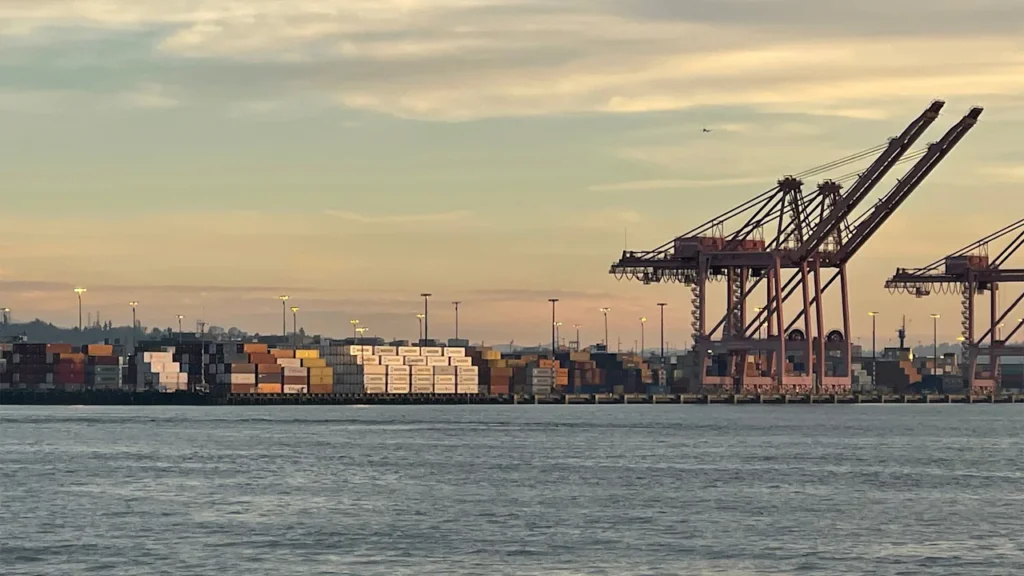
At the Port of Seattle, cargo is always on the move. Longshoremen load and unload cars, electronics, grain, logs, and hundreds of other commodities from ships and trucks before these products land on store shelves around the world.
The life of a longshoreman can be a difficult one, with long and labor-intensive hours spent on the waterfront. Yet, many of them say the work itself is not the most difficult part. Especially in recent months, as unpredictable tariff policies have impacted the number of ships entering U.S. ports, uncertainty is plaguing our ports and the workers who make domestic and global trade possible.
“We’re very fortunate to have the jobs we do and what they pay and the benefits we have, but at the same time, the unknown is what keeps us from enjoying those benefits,” says Kesa Sten, a terminal chief at the Port of Seattle and president of the International Longshore and Warehouse Union (ILWU) Local 52.
An unpredictable number of ships
Within a few weeks of his inauguration, Trump made tariffs a cornerstone of his international policy agenda—but these are not the low, consistent tariffs of past administrations. Broadly implemented and ever evolving, the new administration’s tariff policy has led foreign leaders to scramble for deals and has led importers to wonder: Are these high fees here to stay?
At the ports, this unpredictability has led to inconsistent numbers of ships coming in: busy periods as importers race to get their goods into the country before new tariffs take effect and much slower days while they “wait and see.”
Compared with last year, the number of imports the Port of Seattle is managing is significantly lower, on average, though spikes in activity during pauses or before new tariffs take effect have, in some cases, met or exceeded last year’s averages.
“Just this last week in the Port of Seattle, we were rocking,” Sarah Esch, a dispatcher for ILWU Local 19, told Fast Company in early August. “I think they were just trying to land wherever they could in the U.S. before the August 7 deadline.”
The August tariffs—which were implemented under the International Emergency Economic Powers Act, a law that allows the president to take charge of international commerce regulation during a national emergency—have been deemed illegal by federal courts. However, they will remain in effect until at least October 14 while the case is appealed to the Supreme Court, thereby extending uncertainty for importers and workers at the port.
As dispatcher, Esch will continue to dole out jobs to those working on the waterfront all year. However, now that the busy summer season, when cruise and container ships alike flood Seattle, has come to an end, she is expecting much less work to be available—especially for the newer workers hoping to become registered longshoremen.
Registration comes with big benefits, such as health insurance, retirement, and first pick of available jobs at the port. Getting registered, though, can take many years and comes down to the number of hours worked. As fewer ships dock in times of economic uncertainty and trade instability, fewer jobs are available, and the registration process can become more drawn out and competitive.
“I need to be available, hoping to get work on the waterfront,” Cole Lowenstein, a second-generation longshoreman working in Seattle, tells Fast Company. “It takes me away from a lot of other things.”
Lowenstein has been a casual, the industry term for a dockworker making their way toward registration, for more than six years. During the COVID-19 pandemic, he remembers there was so much work available that casual workers would compete to see how many days in a row they could work, sometimes reaching 30 or 40 days straight. This year, his coworkers were “in awe” of the fact he worked nine days in a row.
With job opportunities slowing down, Lowenstein says he lives 12 hours at a time, always waiting for the next dispatch to see if there will be enough work to warrant staying near the port or if he should make the trek back to his home in northern Washington.
“I spend a lot of time sleeping in my car just because I’m two or three hours away from the house, and it’s not really worth the drive back,” he adds.
These already irregular work schedules have become even more unpredictable in the age of ever-changing tariffs.
What the tariffs are for
High tariffs have been a key part of Trump’s economic strategy since his first term. However, while his first-term tariffs targeted specific imports—such as electric vehicles, semiconductors, and steel, his second term has seen steep, across-the-board tariffs leveled against trading partners. Moves that are baffling to some economists.
“Our president has offered several explanations for the tariffs,” Gene Grossman, an economist and professor at Princeton University’s School of Public and International Affairs, tells Fast Company. “Interestingly they’re in direct contradiction with one another.”
A White House fact sheet related to Trump’s tariffs outlines his goals for the policy: reducing trade deficits, bringing jobs back to the U.S., and raising revenues. Regarding these goals, Grossman says, “you can’t have it both ways.” Bringing jobs stateside would require us to produce more goods here and import less, but importing less does not allow tariffs to bring in revenue.
Still, Trump has moved ahead, creating a complex web of frequently revised tariffs over the past few months. In early February, he imposed steep tariffs on Canada, Mexico, and China, though many were suspended shortly after taking effect in March. He then announced a 10% tariff on all imports to the U.S., which both took effect and was paused on April 9. And despite summer-long negotiations, new tariffs were unexpectedly announced in August. Nearly all U.S. trading partners are impacted by a set of broad-reaching tariffs, which have been in effect since August 7.
“A 15% tariff, if you knew it was going to apply to everybody always and it wasn’t going to be changed next month would be a problem for importers . . . but it would be a known problem,” says Grossman.
The current unpredictable state of global trade is a separate issue for importers, Grossman adds, since it encourages firms that might invest in U.S. trade to wait and see what will happen, rather than acting.
So far, the result of this “wait and see” attitude has been slowdowns in trade—and at the ports. The West Coast has been particularly hard hit, because it processes many imports from China and other countries in Asia that have been hit with high tariffs. Lowenstein has even noticed longshoremen usually based at Southern California ports coming up to Seattle to find work.
“I’ve only heard rumors about how slow it may be [in California], but the rumors are pretty alarming,” Lowenstein says.
What today’s low registrations mean for the future
For Esch, who was in the process of becoming a registered longshoreman during the 2008 recession, the slowdowns today feel familiar. She remembers how the inconsistency of work added an extra dimension of uncertainty to an already difficult registration process.
“I almost moved back home because it had just gotten so dreary and I went through bankruptcy—It was tough, it was really tough,” Esch says. “I’m good now, but, oh my god, I certainly wouldn’t want to be a casual right now.”
Derailing the registration process for the next generation of longshoremen does more than inflict uncertainty on workers, it could destabilize the industry as more longshoremen choose to pursue other careers. After a long slowdown in work, if the number and frequency of ships coming to U.S. ports returns to previous levels, there may not be enough workers to handle their cargo, Lowenstein suggests.
“Entire ships can sit for a day, a night, a shift, two shifts without being unloaded,” he says. “The ripple effects of that through our economy, I couldn’t even begin to articulate.”
The ports are responsible for an estimated $2.89 trillion in economic activity, according to a 2024 report by the American Association of Port Authorities, and they support nearly 22 million jobs.
For now, many working those jobs are sticking it out, hoping the tariffs uncertainty will settle soon. They’re buoyed by the longshore community, which they describe as both vibrant and close-knit—the type of community that rallies around each other in hard times as well as joyous ones.
“It’s just a huge swath of the American public that all work at the same place, getting to know everybody,” Esch says. “We’re together for decades, so it really is like a family.”



